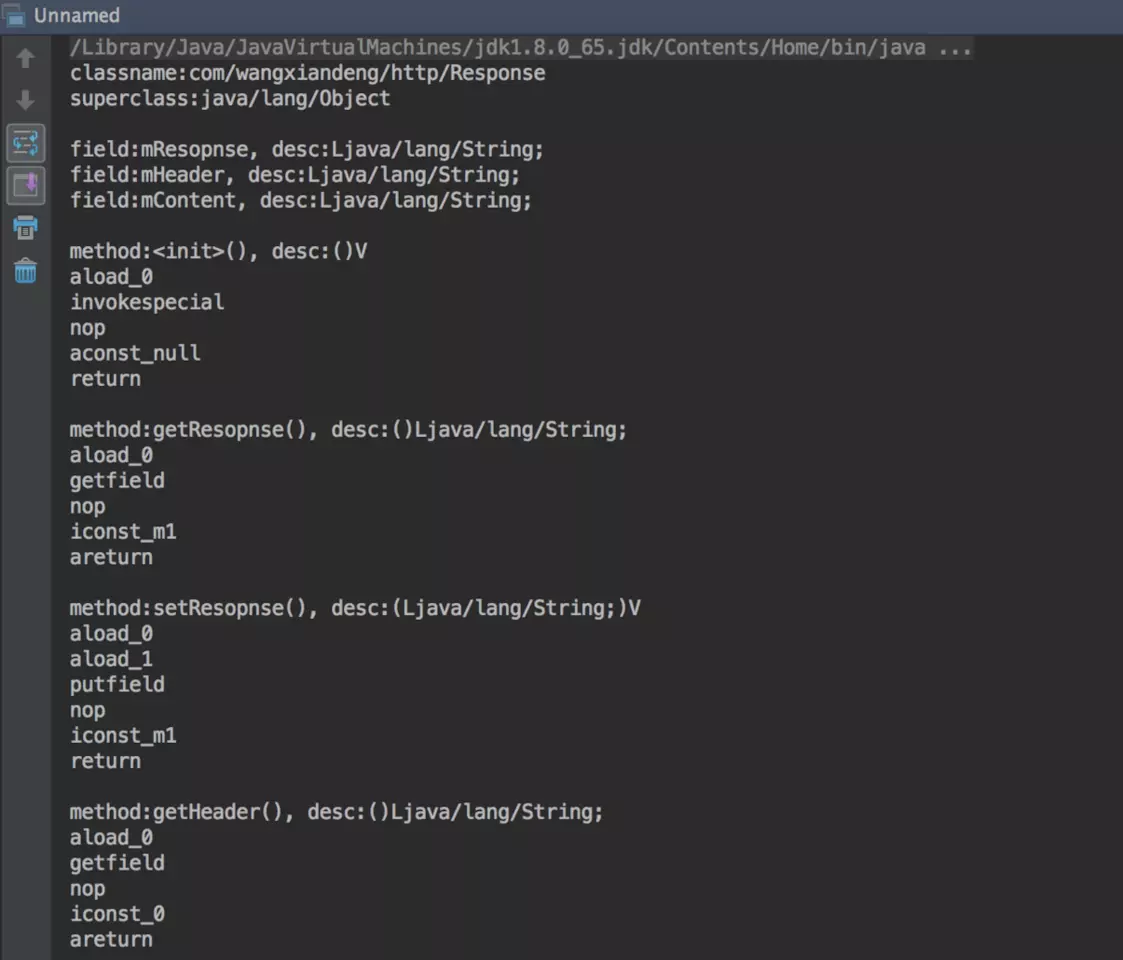本文转自:https://juejin.im/post/589834a20ce4630056097a56
本系列文章将整理到我在GitHub上的《Java面试指南》仓库,更多精彩内容请到我的仓库里查看
喜欢的话麻烦点下Star哈
文章将同步到我的个人博客:
www.how2playlife.com
本文是微信公众号【Java技术江湖】的《深入理解JVM虚拟机》其中一篇,本文部分内容来源于网络,为了把本文主题讲得清晰透彻,也整合了很多我认为不错的技术博客内容,引用其中了一些比较好的博客文章,如有侵权,请联系作者。
该系列博文会告诉你如何从入门到进阶,一步步地学习JVM基础知识,并上手进行JVM调优实战,JVM是每一个Java工程师必须要学习和理解的知识点,你必须要掌握其实现原理,才能更完整地了解整个Java技术体系,形成自己的知识框架。
为了更好地总结和检验你的学习成果,本系列文章也会提供每个知识点对应的面试题以及参考答案。
如果对本系列文章有什么建议,或者是有什么疑问的话,也可以关注公众号【Java技术江湖】联系作者,欢迎你参与本系列博文的创作和修订。
前言
身为一个java程序员,怎么能不了解JVM呢,倘若想学习JVM,那就又必须要了解Class文件,Class之于虚拟机,就如鱼之于水,虚拟机因为Class而有了生命。《深入理解java虚拟机》中花了一整个章节来讲解Class文件,可是看完后,一直都还是迷迷糊糊,似懂非懂。正好前段时间看见一本书很不错:《自己动手写Java虚拟机》,作者利用go语言实现了一个简单的JVM,虽然没有完整实现JVM的所有功能,但是对于一些对JVM稍感兴趣的人来说,可读性还是很高的。作者讲解的很详细,每个过程都分为了一章,其中一部分就是讲解如何解析Class文件。
这本书不太厚,很快就读完了,读完后,收获颇丰。但是纸上得来终觉浅,绝知此事要躬行,我便尝试着自己解析Class文件。go语言虽然很优秀,但是终究不熟练,尤其是不太习惯其把类型放在变量之后的语法,还是老老实实用java吧。
话不多说,先贴出项目地址:github.com/HalfStackDe…
Class文件
什么是Class文件?
java之所以能够实现跨平台,便在于其编译阶段不是将代码直接编译为平台相关的机器语言,而是先编译成二进制形式的java字节码,放在Class文件之中,虚拟机再加载Class文件,解析出程序运行所需的内容。每个类都会被编译成一个单独的class文件,内部类也会作为一个独立的类,生成自己的class。
基本结构
随便找到一个class文件,用Sublime Text打开是这样的:

是不是一脸懵逼,不过java虚拟机规范中给出了class文件的基本格式,只要按照这个格式去解析就可以了:
ClassFile {
u4 magic;
u2 minor_version;
u2 major_version;
u2 constant_pool_count;
cp_info constant_pool[constant_pool_count-1];
u2 access_flags;
u2 this_class;
u2 super_class;
u2 interfaces_count;
u2 interfaces[interfaces_count];
u2 fields_count;
field_info fields[fields_count];
u2 methods_count;
method_info methods[methods_count];
u2 attributes_count;
attribute_info attributes[attributes_count];
}
ClassFile中的字段类型有u1、u2、u4,这是什么类型呢?其实很简单,就是分别表示1个字节,2个字节和4个字节。
开头四个字节为:magic,是用来唯一标识文件格式的,一般被称作magic number(魔数),这样虚拟机才能识别出所加载的文件是否是class格式,class文件的魔数为cafebabe。不只是class文件,基本上大部分文件都有魔数,用来标识自己的格式。
接下来的部分主要是class文件的一些信息,如常量池、类访问标志、父类、接口信息、字段、方法等,具体的信息可参考《Java虚拟机规范》。
解析
字段类型
上面说到ClassFile中的字段类型有u1、u2、u4,分别表示1个字节,2个字节和4个字节的无符号整数。java中short、int、long分别为2、4、8个字节的有符号整数,去掉符号位,刚好可以用来表示u1、u2、u4。
public class U1 {
public static short read(InputStream inputStream) {
byte[] bytes = new byte[1];
try {
inputStream.read(bytes);
} catch (IOException e) {
e.printStackTrace();
}
short value = (short) (bytes[0] & 0xFF);
return value;
}
}
public class U2 {
public static int read(InputStream inputStream) {
byte[] bytes = new byte[2];
try {
inputStream.read(bytes);
} catch (IOException e) {
e.printStackTrace();
}
int num = 0;
for (int i= 0; i < bytes.length; i++) {
num <<= 8;
num |= (bytes[i] & 0xff);
}
return num;
}
}
public class U4 {
public static long read(InputStream inputStream) {
byte[] bytes = new byte[4];
try {
inputStream.read(bytes);
} catch (IOException e) {
e.printStackTrace();
}
long num = 0;
for (int i= 0; i < bytes.length; i++) {
num <<= 8;
num |= (bytes[i] & 0xff);
}
return num;
}
}
常量池
定义好字段类型后,我们就可以读取class文件了,首先是读取魔数之类的基本信息,这部分很简单:
FileInputStream inputStream = new FileInputStream(file);
ClassFile classFile = new ClassFile();
classFile.magic = U4.read(inputStream);
classFile.minorVersion = U2.read(inputStream);
classFile.majorVersion = U2.read(inputStream);
这部分只是热热身,接下来的大头在于常量池。解析常量池之前,我们先来解释一下常量池是什么。
常量池,顾名思义,存放常量的资源池,这里的常量指的是字面量和符号引用。字面量指的是一些字符串资源,而符号引用分为三类:类符号引用、方法符号引用和字段符号引用。通过将资源放在常量池中,其他项就可以直接定义成常量池中的索引了,避免了空间的浪费,不只是class文件,Android可执行文件dex也是同样如此,将字符串资源等放在DexData中,其他项通过索引定位资源。java虚拟机规范给出了常量池中每一项的格式:
cp_info {
u1 tag;
u1 info[];
}
由于格式太多,文章中只挑选一部分讲解:
这里首先读取常量池的大小,初始化常量池:
//解析常量池
int constant_pool_count = U2.read(inputStream);
ConstantPool constantPool = new ConstantPool(constant_pool_count);
constantPool.read(inputStream);
接下来再逐个读取每项内容,并存储到数组cpInfo中,这里需要注意的是,cpInfo[]下标从1开始,0无效,且真正的常量池大小为constant_pool_count-1。
public class ConstantPool {
public int constant_pool_count;
public ConstantInfo[] cpInfo;
public ConstantPool(int count) {
constant_pool_count = count;
cpInfo = new ConstantInfo[constant_pool_count];
}
public void read(InputStream inputStream) {
for (int i = 1; i < constant_pool_count; i++) {
short tag = U1.read(inputStream);
ConstantInfo constantInfo = ConstantInfo.getConstantInfo(tag);
constantInfo.read(inputStream);
cpInfo[i] = constantInfo;
if (tag == ConstantInfo.CONSTANT_Double || tag == ConstantInfo.CONSTANT_Long) {
i++;
}
}
}
}
我们先来看看CONSTANT_Utf8格式,这一项里面存放的是MUTF-8编码的字符串:
CONSTANT_Utf8_info {
u1 tag;
u2 length;
u1 bytes[length];
}
那么如何读取这一项呢?
public class ConstantUtf8 extends ConstantInfo {
public String value;
@Override
public void read(InputStream inputStream) {
int length = U2.read(inputStream);
byte[] bytes = new byte[length];
try {
inputStream.read(bytes);
} catch (IOException e) {
e.printStackTrace();
}
try {
value = readUtf8(bytes);
} catch (UTFDataFormatException e) {
e.printStackTrace();
}
}
private String readUtf8(byte[] bytearr) throws UTFDataFormatException {
//copy from java.io.DataInputStream.readUTF()
}
}
很简单,首先读取这一项的字节数组长度,接着调用readUtf8(),将字节数组转化为String字符串。
再来看看CONSTANT_Class这一项,这一项存储的是类或者接口的符号引用:
CONSTANT_Class_info {
u1 tag;
u2 name_index;
}
注意这里的name_index并不是直接的字符串,而是指向常量池中cpInfo数组的name_index项,且cpInfo[name_index]一定是CONSTANT_Utf8格式。
public class ConstantClass extends ConstantInfo {
public int nameIndex;
@Override
public void read(InputStream inputStream) {
nameIndex = U2.read(inputStream);
}
}
常量池解析完毕后,就可以供后面的数据使用了,比方说ClassFile中的this_class指向的就是常量池中格式为CONSTANT_Class的某一项,那么我们就可以读取出类名:
int classIndex = U2.read(inputStream);
ConstantClass clazz = (ConstantClass) constantPool.cpInfo[classIndex];
ConstantUtf8 className = (ConstantUtf8) constantPool.cpInfo[clazz.nameIndex];
classFile.className = className.value;
System.out.print("classname:" + classFile.className + "
");
字节码指令
解析常量池之后还需要接着解析一些类信息,如父类、接口类、字段等,但是相信大家最好奇的还是java指令的存储,大家都知道,我们平时写的java代码会被编译成java字节码,那么这些字节码到底存储在哪呢?别急,讲解指令之前,我们先来了解下ClassFile中的method_info,其格式如下:
method_info {
u2 access_flags;
u2 name_index;
u2 descriptor_index;
u2 attributes_count;
attribute_info attributes[attributes_count];
}
method_info里主要是一些方法信息:如访问标志、方法名索引、方法描述符索引及属性数组。这里要强调的是属性数组,因为字节码指令就存储在这个属性数组里。属性有很多种,比如说异常表就是一个属性,而存储字节码指令的属性为CODE属性,看这名字也知道是用来存储代码的了。属性的通用格式为:
attribute_info {
u2 attribute_name_index;
u4 attribute_length;
u1 info[attribute_length];
}
根据attribute_name_index可以从常量池中拿到属性名,再根据属性名就可以判断属性种类了。
Code属性的具体格式为:
Code_attribute {
u2 attribute_name_index; u4 attribute_length;
u2 max_stack;
u2 max_locals;
u4 code_length;
u1 code[code_length];
u2 exception_table_length;
{
u2 start_pc;
u2 end_pc;
u2 handler_pc;
u2 catch_type;
} exception_table[exception_table_length];
u2 attributes_count;
attribute_info attributes[attributes_count];
}
其中code数组里存储就是字节码指令,那么如何解析呢?每条指令在code[]中都是一个字节,我们平时javap命令反编译看到的指令其实是助记符,只是方便阅读字节码使用的,jvm有一张字节码与助记符的对照表,根据对照表,就可以将指令翻译为可读的助记符了。这里我也是在网上随便找了一个对照表,保存到本地txt文件中,并在使用时解析成HashMap。代码很简单,就不贴了,可以参考我代码中InstructionTable.java。
接下来我们就可以解析字节码了:
for (int j = 0; j < methodInfo.attributesCount; j++) {
if (methodInfo.attributes[j] instanceof CodeAttribute) {
CodeAttribute codeAttribute = (CodeAttribute) methodInfo.attributes[j];
for (int m = 0; m < codeAttribute.codeLength; m++) {
short code = codeAttribute.code[m];
System.out.print(InstructionTable.getInstruction(code) + "
");
}
}
}
运行
整个项目终于写完了,接下来就来看看效果如何,随便找一个class文件解析运行:

哈哈,是不是很赞!
最后再贴一下项目地址:github.com/HalfStackDe…,欢迎Fork And Star!
总结
Class文件看起来很复杂,其实真正解析起来,也没有那么难,关键是要自己动手试试,才能彻底理解,希望各位看完后也能觉知此事要躬行!
参考:
(如有错误,欢迎指正!)
(转载请标明ID:半栈工程师,个人博客:halfstackdeveloper.github.io)